By Dylan Bickerstaffe. Published in Egyptological, Magazine Edition 8, 18th April 2013
Part One: The Royal Pose in Death
Background
Amongst the many miracles through which delicate objects are preserved from ancient Egypt down into modern times, perhaps the most remarkable is the survival of the mortal remains of a virtually complete sequence of New Kingdom rulers. These kings, along with a number of queens and lesser royalty – who date from the end of the Seventeenth Dynasty through to the start of the Twenty-Second Dynasty – are generally referred to as the Royal Mummies, and were for the most part recovered from the Royal Cache of 1881 (in tomb TT320), and the Second Royal Cache of 1898 (in tomb KV35, the tomb of Amenhotep II).
Although the identity of some of the Royal Mummies (for instance that of Tutankhamun) is virtually certain, the identification of others as famous royal figures is far less secure, and there have been extensive debates over a number of them, with various attempts made at reshuffling kings among mummies to achieve a more ‘satisfactory’ fit, in a kind of ‘musical chairs’ exercise.
In my book, Identifying the Royal Mummies (see note 1), I weigh-up the likelihood of the identity proposed for each of the Royal Mummies, on the basis of the techniques generally employed. The most important of these methods is the examination of surviving ancient inscriptional evidence, though (owing to extensive plundering of New Kingdom royalty at the end of the Twentieth Dynasty), this was often actually a re-labelling by officials in the following era of Twenty First Dynasty priest-kings. Other techniques that have been used to try and support or deny the identity of royal mummies include: observation of whether there appears to be a family likeness between supposedly related individuals; an assessment of whether the mummification techniques employed seem appropriate for the period in which the person was originally buried; and an assessment of the age at which the individual died, as compared to what is known from historical data. Finally there is the question of whether the pose in which the body was laid-out (specifically the position of the arms) seems in accordance with what is expected for a king or queen, or lesser royal person, during the period in question.
I discussed the last point at some length in Identifying the Royal Mummies in the section The Royal Pose in Death: The Arm Positions of the Royal Mummies (Pages 18-28, and Table – The Royal Mummies: Pose and Colour, 54-62), but, as I showed there, the question goes beyond the variety of poses adopted by the royal mummies themselves to the broader question of the symbolism of comparable poses depicted on royal coffins, sarcophagi, shabtis, funerary papyri etc., – as well as those seen in a number of royal statue types, most notably ‘Osiride’ statues – and how each of these compares to non-royal examples during various periods.
The subject is thus vast, and provides scope for research into a whole series of different topics, which I have, to date, been able to do no more than touch upon. In a sense, therefore, this piece (and those that will hopefully follow) represent a sort of ‘call to arms’, a request for collaborators who may be able to advance our understanding – perhaps by tackling a specific sub-topic – and thereby add to the total picture. Sometimes people struggle to think of a suitable research topic. There are plenty of fruitful themes to be found here!
The Pose of the Royal Mummies
The starting point for this study was the question – in what pose should the Pharaohs of the New Kingdom have been laid-out for burial? It is often stated that the normal pose was with the arms crossed high on the chest, right over left, so that the clenched hands (which presumably once held the flail and crook respectively) each lay on the opposite shoulder. Of course, in reality things are not so straightforward, and of all the royal mummies, only Merenptah (CCG 61079) conforms exactly to this ‘typical’ pose. Indeed, it is necessary to look no further than the mummy of Tutankhamun to find a significant exception to the rule, and it is a good job that he was discovered in such unequivocal circumstances – surrounded by identifying information – because his mummy was found posed with the arms crossed horizontally across the stomach, left above the right, which would surely, in less fortunate circumstances, have led to his identity or royal status being questioned. In spite of this, the ‘typical’ pose has come to be used as a basic yardstick for determining whether a particular mummy is that of a king, or not. Indeed, the identity of the mummy of the founder of the Eighteenth Dynasty, Ahmose I (CCG 61057), which is one of the few royal mummies to be identified upon original bandaging – as well as on wrappings and on the coffin provided by restorers in the later, Twenty-First Dynasty – has on occasion been doubted owing to it being posed with the arms pendant at the sides of the body.
Conversely, an anonymous mummy which had lain in the Niagara Falls Museum from as early as 1861 was thought to be a pharaoh because the arms were crossed high on the chest, right over left, and, after intense scrutiny, identified as the hitherto missing mummy of Ramesses I. It is ironic that the mummy was thought to most closely resemble those of Seti I and Ramesses II (son and grandson, respectively, of Ramesses I) because these two mummies (CCG 61077 & 61078) are unique in being posed with the left arm crossed over the right, the opposite of the ‘typical’ pose seen in the Niagara Falls mummy. This ‘reversed’ pose, with the left arm superior to the right, might perhaps have been adopted by the new ruling house (the Nineteenth Dynasty) hailing from Lower Egypt, and naturally one would have expected Ramesses I, as it’s founder, to have set the trend followed by his successors. That the arms of the Niagara Falls mummy are the wrong way round is but one of many reasons why it is unlikely to be Ramesses I.
In fact the Niagara Falls mummy is not laid-out in exactly the classic, ‘typical’ pose because the right hand is open, whilst the left hand is clenched with the thumb extended, as though grasping a sceptre. This exact hand-pose is actually seen in the mummies of just three kings, all of the early Eighteenth Dynasty – Amenhotep I (CCG 61058); Thutmose II (CCG 61066); and Thutmose III (CCG 61068). The Niagara Falls mummy, however, appears to date to the late Twenty-Second Dynasty, and I have discussed at length elsewhere how he (and other examples from the same and later periods) came to be laid-out in this pose (note 2). In contrast the mummies of Ramesses I’s immediate descendants, Seti I and Ramesses II, are laid-out with their hands open, a posture repeated in the mummies of kings surviving from the Twentieth Dynasty.
The mummies of New Kingdom queens present a similar challenge to the commonly stated stereotype. Here the supposedly typical pose is that seen on statues where the queen holds a lily-sceptre is her left hand. In the ‘Lily Pose’ the left arm is crossed high on the chest with the fist clenched and thumb extended (as through to grasp the sceptre), and the right arm lying straight down by the side with the hand laid open. This pose has been noted in the mummies of women buried in tombs KV60 and KV21 in the Valley of the Kings, but the likelihood is that these were senior courtiers, perhaps wet nurses, rather than queens. Ironically the remains of the mummy found in tomb KV55 (CCG 61073), were said to have been found laid-out in this exact pose, and this was used to support the case for it having been Queen Tiye, until it was confirmed that the mummy was male. Later, the same pose exhibited by the mummy known as the Elder Lady (CCG 61070) – discovered in side room ‘C’ of tomb KV35 – encouraged researchers to seek proof that she was the otherwise missing Queen Tiye. Probably all these examples date to the mid/late Eighteenth Dynasty. However, the mummies of queens and princesses of the early Eighteenth Dynasty were generally laid out with their hands on the front of their thighs, or, as in the case of the semi-divine Ahmose Nefertari, with the hands covering the pudenda. In the Twenty-First Dynasty the favoured position was with the hands either at the side of, or on the front of, the thighs.
Clearly what has been presented here is far from an exhaustive study, but the examples cited above do give some idea of the range of postures in which royalty of the New Kingdom might be laid-out. It has to be acknowledged that, in the case of kings, these were most often variations on some sort of crossed-arm pose, but that there were apparently trends within this, with preferences shown for a particular hand-arm pose in a particular era. However, the significance of neither the basic crossed-arm pose nor any of the specific variations is clear.
The Pose of Non-Royals
The incidence of the crossed-arm pose (and others) amongst royalty is significant only in so far as it differs from that of the general population, of course. In general it can be said that, before the Ptolemaic era, commoners were laid out with their arms extended straight so that the hands rested on the thighs or covered the pudenda. The crossed-arm pose becomes relatively commonplace during the Ptolemaic period, and is still found occasionally in the Roman period (see note 3). Increasingly, however, mummies of high status males laid out in the crossed-arm pose are recognised as dating from the Twenty-Fifth or Twenty-Sixth Dynasties, or even as early as the late Twenty-Second Dynasty. It may be significant that amongst these mummies it is not uncommon for the left hand to be clenched (with thumb extended), and the right laid open. Just to prove that no rules can ever be considered totally infallible, the example should be noted of the female mummy found in the coffin of the Nineteenth Dynasty Deir el Medina foreman, Sennedjem. She was posed with her arms crossed, right-over-left, with the left hand clenched (the thumb extended), and the right hand open! (see note 4)
In the space available here I shall briefly consider the poses exhibited on anthropoid coffins since these often display the crossed-arm pose.
The Pose of the Royal Coffins
It was not until the Middle Kingdom that coffins in the shape of a person (known as anthropoid) began to appear alongside the more traditional rectangular box – or slightly more elaborate ‘Per Nu’ – form seen hitherto. The earliest known anthropoid example was, in fact, royal, and belonged to a wife of Nebhepetre Mentuhotep. Such early examples were intended to lie within the outer ‘box’ coffin, and were an imitation of the wrapped mummy wearing a mask, and thus were depicted without arms. By the Seventeenth Dynasty, kings, such as Nubkhepere Intef, Seqenenre Ta’o, and Kamose, (and other elite figures), began to be buried in anthropoid coffins in which the body, apart from the headdress, was represented as though enfolded by the wings of birds (a style known as ‘rishi’, or feathered), and thus still concealed the presence of arms (see note 5).
The fact that many of the New Kingdom royalty found inside the two royal caches had, when reburied in the early Twenty-First Dynasty, been provided with replacement coffins – often purloined from non-royal burials – means it is hard to be definitive, but the earliest examples known of coffins depicting arms are the colossal outer coffins belonging to queens of the early Eighteenth Dynasty, such as Ahhtope, Ahmose Nefertari, and Meryetamun. In all three cases the arms were crossed, right over left, to place Ankh or papyrus symbols against the opposite shoulder.
In the case of the kings, the first crossed-arms examples are those surviving from the coffin sets of Thutmose I and Thutmose III, and here the arms are depicted crossing high on the chest, right over left, the hands clenched but apparently empty. This same pose is subsequently seen in the coffins of private individuals – most famously the third and fourth coffins of Maiherpri, the second and third coffins of Yuya, and the second coffin of Thuya. These examples illustrate the fact that the tradition of an outer, rectangular, container (the first coffin) persisted; and both Yuya and Thuya demonstrate that the inner-most coffin might still be depicted without arms. The majority of the non-royal coffins provided for the reburial of royalty collected in the two royal caches conformed to the same basic right-over-left, crossed-arms pose, with hands laid open or clenched.
It is perhaps the three wonderful coffins of Tutankhamun, on each of which the right hand bearing the flail crosses over the left grasping the crook, that have given us the impression that this is the classic pose of the king in death. This precise pose and arrangement of sceptres is also seen in the coffin provided in the Twenty First Dynasty for the reburial of Ramesses II.
The coffins of the Twenty First Dynasty continue the pattern of right-over-left crossed arms, for both sexes. Though the hands are missing from many of these coffins – owing to the gilding having attracted the cupidity of thieves – it is possible to say that male coffins generally sported clenched hands, whilst female coffins could have the hands clenched or laid open.
The Scope of the Problem
Here there has been the opportunity to do no more than briefly review the poses displayed by royal mummies and royal anthropoid coffins. In the case of coffins it is clear that the right-over-left crossed-arms pose rapidly became the norm amongst royalty and commoners of both sexes, with some specific variations in hand posture, and sceptres grasped. However, the royal mummies display considerable variation from the basic pattern, even allowing for a different basic pose for each sex.
The significance of the crossed arm pose is unclear, but further light will be shed as it is traced across sarcophagi, shabtis, Osiride statues, etc.
Notes
- Dylan Bickerstaffe, Identifying the Royal Mummies, Part 4 of Refugees for Eternity: The Royal Mummies of Thebes. Canopus Press 2009. ISBN 978 0 9561875 1 2; can be obtained direct via www.dylanb.me.uk.
- See Identifying the Royal Mummies, 100 & 112-120; also, Dylan Bickerstaffe, ‘Examining the Mystery of the Niagara Falls Mummy. Was he from the Royal Mummies Cache? And is he Ramesses I?’, KMT 17.4 (Winter 2006-07), 26-34; and ‘The (Royal) Mummy Returns…but is he Ramesses I?’, Ancient Egypt 6.2/32 (Oct/Nov 2005), 42-48.
- See the analysis performed by P. H. K. Gray, ‘Position of Arms and Hands of Mummies’ JEA 58, 200-203.
- See the photograph (page 34) in, Zahi Hawass, ‘The EMP: Egyptian Mummy Project’, KMT 15.4 (Winter 2004-5), 29-38.
- This summary is based on Salima Ikram and Aidan Dodson, The Mummy in Ancient Egypt: Equipping the Dead for Eternity, London 1998, 196-206.
Image Credits
Figure 1. Howard Carter inspecting one of the coffins of Tutankhamun. Public Domain.
Figure 2. Shabti of Tutankhamun. Photograph by Jon Bodsworth. Copyright free use.
Figure 3. The Coffins of Seti I (19th Dynasty) & Isiemkheb (21st Dynasty). Copyright Dylan Bickerstaffe
Figure 4. The Coffin lid of Ramesses II. Copyright Dylan Bickerstaffe
Figure 5. The “Elder Lady” from tomb KV55. Public Domain
Figure 6. Dr Granville’s Mummy, from Thebes, 600BC
Figure 7. The Coffin of Ahhtope Early 18th Dynasty. Public Domain
Figure 8. Coffinette of Tutankhamun. Photograph by Kaveh. Shared under the Creative Commons Attribution-Share Alike 2.5 Generic license.
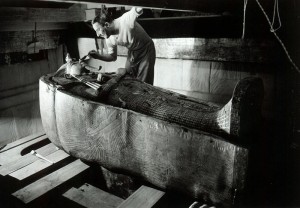
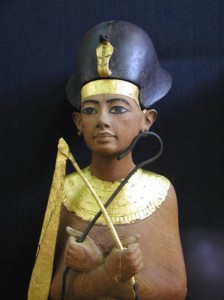
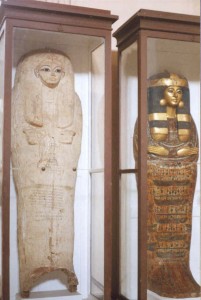

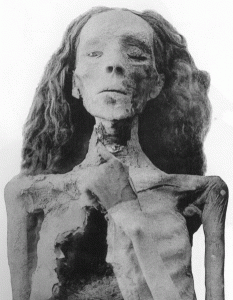
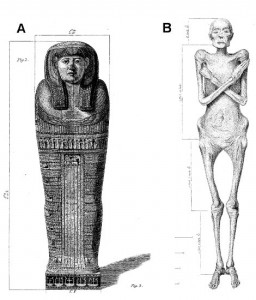

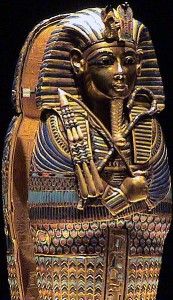
 By
By